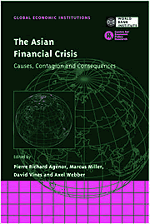Book contents
- Frontmatter
- Contents
- List of figures
- List of tables
- Preface
- List of conference participants
- Acknowledgements
- List of abbreviations and acronyms
- Introduction
- Part One General Accounts
- 1 The role of macroeconomic and financial sector linkages in East Asia's financial crisis
- Discussion
- 2 The Asian crisis: lessons from the collapse of financial systems, exchange rates and macroeconomic policy
- Discussion
- 3 Are capital inflows to developing countries a vote for or against economic policy reforms?
- Discussion
- 4 The Asian crisis: an overview of the empirical evidence and policy debate
- Discussion
- Part Two Theoretical Contributions
- Part Three Contagion
- Part Four Policy Responses
- Index
1 - The role of macroeconomic and financial sector linkages in East Asia's financial crisis
from Part One - General Accounts
Published online by Cambridge University Press: 26 February 2010
- Frontmatter
- Contents
- List of figures
- List of tables
- Preface
- List of conference participants
- Acknowledgements
- List of abbreviations and acronyms
- Introduction
- Part One General Accounts
- 1 The role of macroeconomic and financial sector linkages in East Asia's financial crisis
- Discussion
- 2 The Asian crisis: lessons from the collapse of financial systems, exchange rates and macroeconomic policy
- Discussion
- 3 Are capital inflows to developing countries a vote for or against economic policy reforms?
- Discussion
- 4 The Asian crisis: an overview of the empirical evidence and policy debate
- Discussion
- Part Two Theoretical Contributions
- Part Three Contagion
- Part Four Policy Responses
- Index
Summary
Introduction
Private capital flows to developing countries increased sixfold over the years 1990 to 1996. These large inflows were not simply an independent and isolated macroeconomic shock but rather the manifestation of structural changes in the world economic environment and in developing countries themselves. The structural changes resulted in the transition by many countries from near financial autarky to fairly close integration with world capital markets. The capital inflow phenomenon, and the associated need to intermediate efficiently large amounts of foreign capital and address potential macroeconomic overheating, were the direct products of the transition between these polar financial integration regimes.
Countries in East Asia were at the forefront of the worldwide movement toward increased financial integration (see World Bank, 1997) and are good examples of both the benefits, and the risks, of integration. East Asian countries fared quite well during the initial stages of this integration process, especially in comparison with many developing countries outside the region. Indeed, in many ways lessons to be applied elsewhere regarding the appropriate adjustment to large capital inflows have been drawn from the experiences of East Asia (for example, Corbo and Hernandez, 1996). Countries in the region also weathered the storm associated with the Mexican currency crisis of December 1994 in relatively good form, suggesting that the policies they adopted to manage inflows also proved effective in rendering them relatively less vulnerable to a financial shock that created serious disruptions elsewhere. Nonetheless, the summer of 1997 and events since have made clear that this view could no longer be sustained.
- Type
- Chapter
- Information
- The Asian Financial CrisisCauses, Contagion and Consequences, pp. 9 - 64Publisher: Cambridge University PressPrint publication year: 1999
- 6
- Cited by



